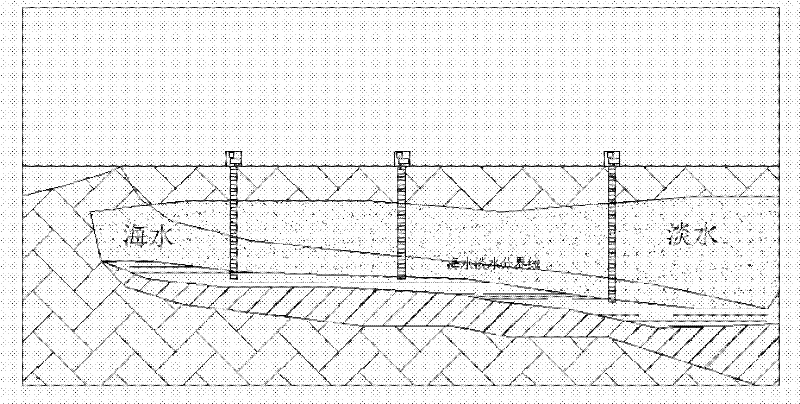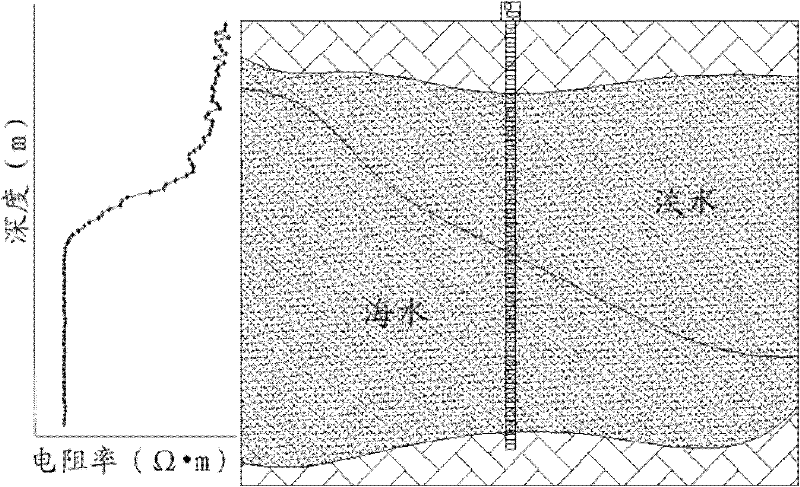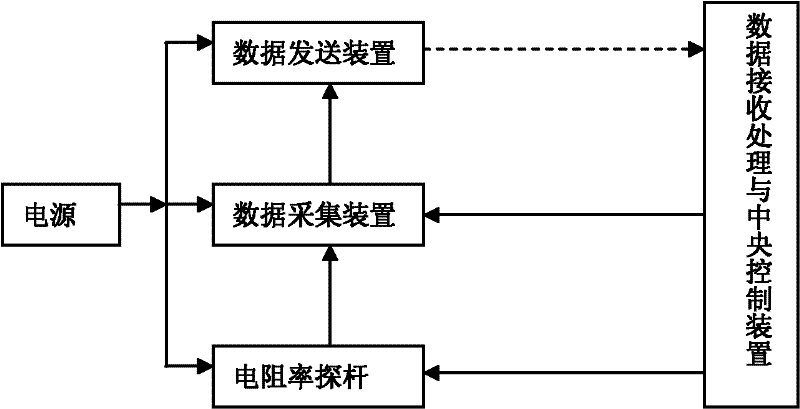An in-situ automatic monitoring method and system for the range and degree of underground seawater intrusion
A seawater intrusion and automatic monitoring technology, applied in the field of underground exploration, can solve the problems of monitoring time and period limitations, large manpower and material resources, and inability to monitor seawater distribution, so as to avoid complicated work and improve accuracy.
- Summary
- Abstract
- Description
- Claims
- Application Information
AI Technical Summary
Problems solved by technology
Method used
Image
Examples
Embodiment 1
[0035] Embodiment 1: Establish a standard curve between the seawater content and the resistivity value in the aqueous medium in the monitoring area
[0036] After fully cleaning the sand samples taken from Liuqinghe Beach in Qingdao, they were dried in a blast dryer at 105°C, and the dried sand samples were saturated according to the seawater / freshwater ratio listed in the table. Measure the resistivity value with the resistivity probe rod with the electrode ring spacing of 0.5cm, 1.0cm and 2.0cm, and convert the resistivity value into the conductivity value by taking the reciprocal of the resistivity value, and use the excel software to establish a standard curve, and perform numerical fitting to obtain the conductivity value (S / m) and seawater accounted for fresh water percentage (%) relationship. R according to the curve 2 The value selects the optimal electrode spacing. The conductivity of fresh water here is 0.02S / m, and that of pure seawater is 3.48S / m.
[0037] See T...
Embodiment 2
[0051] Embodiment 2: Using a resistivity probe rod with an electrode spacing of 2.0 cm to be used in an indoor simulated seawater intrusion experiment, the monitoring results are as follows:
[0052] Table 4 Indoor test monitoring results
[0053] Depth / cm
[0054] The monitoring results obtained from the indoor test show that at a depth of 80cm or more, the resistivity value is relatively large, and the degree of seawater mixing is low, which can be regarded as a freshwater area. In the transition zone, the resistivity value below 110cm is very small, which can be regarded as a seawater zone. It can be seen that due to buoyancy and other reasons, pure fresh water is on the top layer, the middle is a mixed layer of sea water and fresh water, and the bottom layer is a sea water layer. It can also be seen from the above table that the resistivity has a sudden change at around 25Ω·m, and this value can be used as the standard value of the seawater / fresh water boundary. ...
Embodiment 3
[0055] Embodiment 3 field actual observation
[0056] A site monitoring experiment was carried out at a point in the alluvial plain area of the lower reaches of the Licun River. Firstly, soil columnar samples were taken for analysis, and the sampling depth was 10m. The analysis shows that the underground in this area is mainly fine sandy soil, mixed with medium-coarse sand at the upper 2-4m. The length of the resistivity probe rod is processed to 10m, the distance between the electrode rings is 2cm and buried in the drill hole, the remote control device is used to send signals to the resistivity probe rod and the data acquisition device, and the on-site resistivity acquisition is carried out after the probe rod receives the signal. The collected signal is preliminarily processed by the data processing device and transmitted to the data sending device, and the data sending device sends it to the data receiving and processing device through the wireless network. Afterwards, ...
PUM
| Property | Measurement | Unit |
|---|---|---|
| electrical resistivity | aaaaa | aaaaa |
| electrical conductivity | aaaaa | aaaaa |
| electrical resistivity | aaaaa | aaaaa |
Abstract
Description
Claims
Application Information
 Login to View More
Login to View More - R&D
- Intellectual Property
- Life Sciences
- Materials
- Tech Scout
- Unparalleled Data Quality
- Higher Quality Content
- 60% Fewer Hallucinations
Browse by: Latest US Patents, China's latest patents, Technical Efficacy Thesaurus, Application Domain, Technology Topic, Popular Technical Reports.
© 2025 PatSnap. All rights reserved.Legal|Privacy policy|Modern Slavery Act Transparency Statement|Sitemap|About US| Contact US: help@patsnap.com



